|
|
Post by jamesw on Oct 20, 2013 3:54:49 GMT
Don't collect these but (I say that way too often!) picked these up today, just because I thought they were pretty.  |
|
I.L.S.
Departed
Rest in Peace
I am in Clearfield, Pa. I love US Classic covers!
Posts: 2,113 
|
Post by I.L.S. on Oct 20, 2013 7:58:23 GMT
Wow isn't that great looking? Love it! Now what does it say?
|
|
ncbucki
Member  Inactive
Greetings to all! I really do like having individual forums based on global area. Many
Inactive
Greetings to all! I really do like having individual forums based on global area. Many
Posts: 143 
|
Post by ncbucki on Jan 1, 2014 15:59:09 GMT
If I may, I would like to add to this thread. I'm not sure of the time period for this postal card, but I'm guessing in the 1920-1930's. 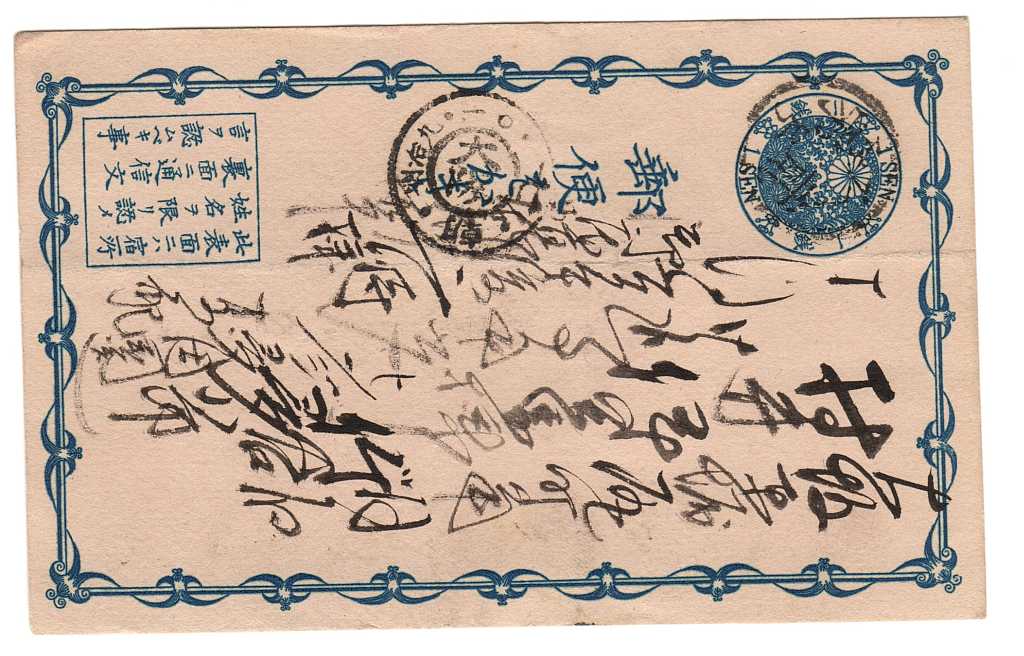 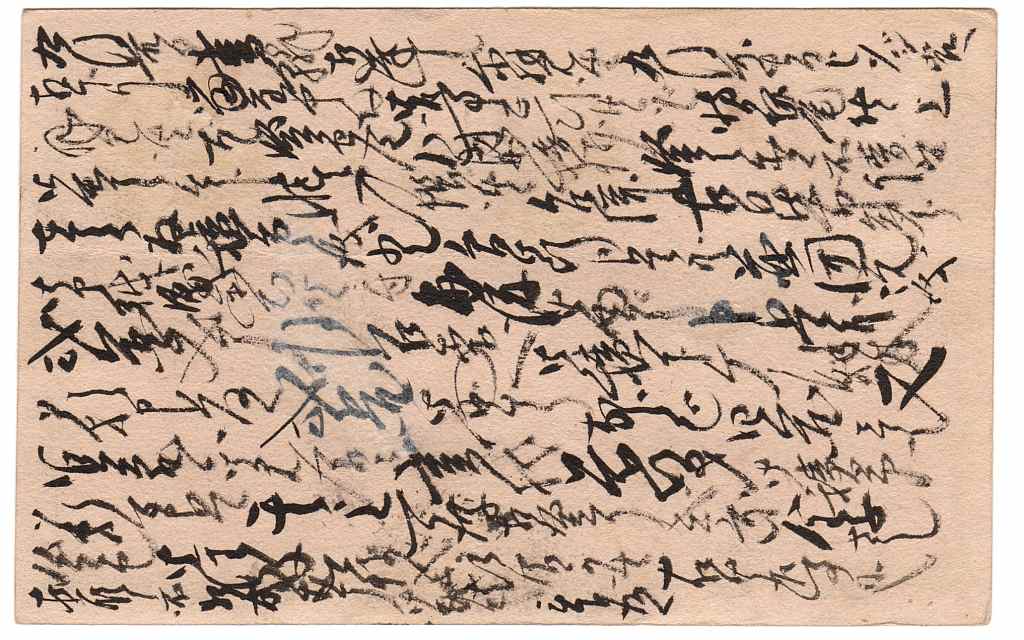 |
|
ncbucki
Member  Inactive
Greetings to all! I really do like having individual forums based on global area. Many
Inactive
Greetings to all! I really do like having individual forums based on global area. Many
Posts: 143 
|
Post by ncbucki on Jan 1, 2014 16:23:37 GMT
I believe this Japanese post card is from around 1900-1910. 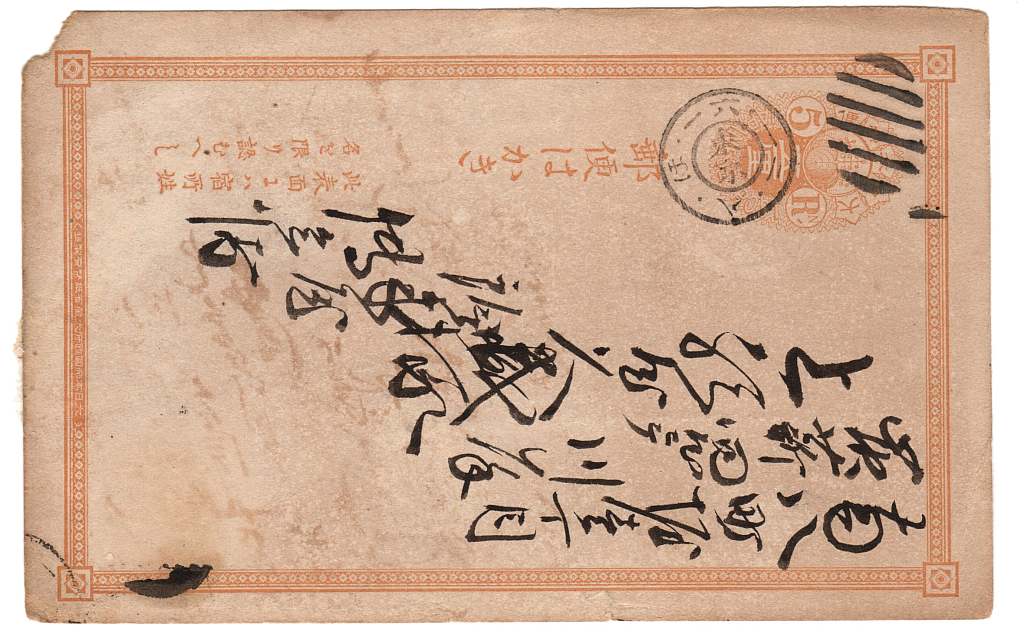 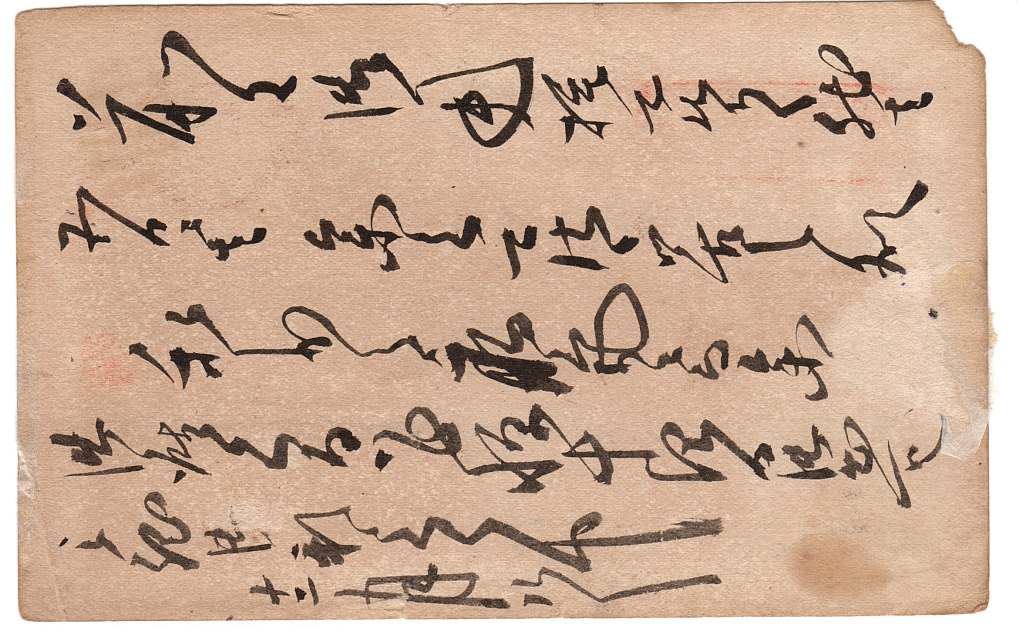 |
|
seigaku
Member  Inactive
Inactive
Posts: 60  What I collect: Latin America, Japan, specialized Mexico (MEPSI member)
What I collect: Latin America, Japan, specialized Mexico (MEPSI member)
|
Post by seigaku on Mar 22, 2018 19:47:49 GMT
This is about how the lottery for New Year's souvenir sheets works, which may be a mystery to many collectors. Each New Year's postcard has a lottery entry number in the lower right corner. This postcard is from year Heisei 11, which can be seen in the center bottom picture of Mt. Fuji. Year 1 of Heisei was western 1989 (there is no year zero), so this would be 1999. The post office publishes the winning lottery numbers (see the announcement for Heisei 8, which was annotated by a fiend of mine). The New Year's souvenir sheets are 4th prize. Since there are three 2-digit winners out of 100 possible, winning percentage is about 3%. The postcard shown was a lottery winner, and was taken to the post office on January 28 of Heisei 11 or 1999, and the postal clerk cancelled the lottery number. People could claim winners from any of the New Year's cards they received, or also from any unused New Year's cards they had remaining. Stamp collectors like my friend would often buy an entire set of 50-odd New Year's postcards to assure that they would get a souvenir sheet. That is a cost of US$30 or more, so the catalog price of a few dollars isn't too bad, economically. (More in the next post)   |
|
seigaku
Member  Inactive
Inactive
Posts: 60  What I collect: Latin America, Japan, specialized Mexico (MEPSI member)
What I collect: Latin America, Japan, specialized Mexico (MEPSI member)
|
Post by seigaku on Mar 22, 2018 20:06:23 GMT
This is about full year sets of Japanese New year's postcards. There is a New Year's postcard that can be obtained all over the country, but there are also "Furosato" postcards that can be obtained only in their specific province or at the Tokyo Central Post Office. A full set is around 50 postcards. Unlike the national postcard, the provincial postcards are semi-postal--you can see the +3 in the value of this example, which is from Heisei 10 or 1998. Also, this example is exactly that--it is a "mihon" which is spelled phonetically by the three overprint characters, meaning sample or specimen. These example postcards were displayed at the local post offices, and the lottery number was null as can be seen in the lower right. Each provincial postcard has an attractive painting on the other side. This provincial mihon was from Tokyo, and shows a painting of a Tokyo scene. The different provincial designs are artistically attractive and fun to collect, but are worth very little if you want to sell them.   |
|
tobben63
Member  Stamp eat sleep repeat
Stamp eat sleep repeat
Posts: 1,874  What I collect: I collect to much, world wide!
What I collect: I collect to much, world wide!
|
Post by tobben63 on Aug 1, 2018 17:22:47 GMT
And I have 9 different of these, but what are they?  |
|
salentin
Member  collecting Germany,where I live and about 20 more countries,half of them in Asia east of the Indus
collecting Germany,where I live and about 20 more countries,half of them in Asia east of the Indus
Posts: 6,506 
|
Post by salentin on Aug 1, 2018 18:00:09 GMT
And I have 9 different of these, but what are they? Inland post card,issued May 25th,1899. |
|
salentin
Member  collecting Germany,where I live and about 20 more countries,half of them in Asia east of the Indus
collecting Germany,where I live and about 20 more countries,half of them in Asia east of the Indus
Posts: 6,506 
|
Post by salentin on Aug 1, 2018 18:09:41 GMT
I believe this Japanese post card is from around 1900-1910. Domestic postcard,issued Sept.19th,1876 |
|
salentin
Member  collecting Germany,where I live and about 20 more countries,half of them in Asia east of the Indus
collecting Germany,where I live and about 20 more countries,half of them in Asia east of the Indus
Posts: 6,506 
|
Post by salentin on Aug 1, 2018 18:12:24 GMT
If I may, I would like to add to this thread. I'm not sure of the time period for this postal card, but I'm guessing in the 1920-1930's. Domestic postcard,issued June 12th,1875 |
|
unechan
Member 
Posts: 157
What I collect: pre WW2 Japan (mostly Meiji era classics and semi-classics); Japan revenue and cinderella; Germany infla
|
Post by unechan on Nov 23, 2018 13:06:25 GMT
Dear all, my first post (besides my self introduction) on this Forum; I do collect Japanese post cards so would like to add some observations on the examples of the beautiful classics posted here. The postcards posted by jamesw and tobben63 are, as explained by salentin, domestic post card, issued May 25th, 1899. They are called as "Kiku blue frame postcards" as they have the same design as the Kiku (chrysanthemum) stamps, and also have frame around the margin in blue. What is interesting about these two examples are the different date stamps used; the Bisected Circle type ("Maru-ichi-In") and Trisected Circle type ("Maru-Ni-In"). The Trisected Circle type datestamps were used during Meiji 33 (1900) and Meiji 38 (1905) at Tokyo, Osaka, Kobe, Yokohama and Nagasaki and their inter-city post offices to replace the Bisected Circle type datestamps. During this (approximately five-year) period, at other locations, the Bisected Circle datestamps were still used, thus various combination of Bisected and Trisected circle type datestamps could be found. And miraculously, we can observe the two different combinations on the two postcards by jamesw and tobben63;  - Hironobu |
|
unechan
Member 
Posts: 157
What I collect: pre WW2 Japan (mostly Meiji era classics and semi-classics); Japan revenue and cinderella; Germany infla
|
Post by unechan on Nov 23, 2018 13:52:39 GMT
Dear all, another observation on the posted example. The second example posted by ncbucki (as mentioned by salentin) is a domestic 5 Rin postcard issued September 19, Meiji 9 (1876). This postcard, together with the blue 1 Sen postcard, is called as "Koban postcard" due to the shape of the imprinted part (Koban is an oval shaped ancient Japanese coin). The 5 Rin postcard was for reduced fee for city post mail (e.g. delivery within the local limited area). This reduced fee for city post mail has been discontinued on January 1st, Meiji 16 (1883) and a uniform fee of 1 Sen has been adopted. In order to manage this change, the post office attached a 5 Rin stamp (Old Koban) on the right-lower corner and sold the postcard as 1 Sen postcard. On the example by ncbucki one can find a trace of Tokyo large Bota cancel and Double Circle type date stamp, thus it is likely that the affixed 5 Rin stamp has fallen out. Fortunately I own an example from the same year which still has the Old Koran 5 Rin stamp intact.  The usage of this 5 Rin postcard is very interesting. As there were very limited need for city post mail in local cities and towns, the usage of 5 Rin postcard before Meiji 9 (1876) is almost limited in large cities such as Tokyo, Yokohama, Osaka, Kyoto and Kobe. So, a 5 Rin postcard bearing cancellations of local cities (especially with "Ki-Ban" cancel = Single circle symbol/character cancellations) is pretty scarce... Also, even after the fee uprating on January 1st, the postcard fee for city post mail has been kept to 5 Rin as a transient measure until February 20, Meiji 16 (1883). Therefore, one may find a 5 Rin postcard bearing Large Bota cancel of Tokyo and other large cities WITHOUT the additional 5 Rin franking during Jan 1st and Feb 20, 1883 (which is also pretty scarce). There are other interesting usage of this 5 Rin postcard, and I would show some examples here in the near future. -Hironobu |
|
unechan
Member 
Posts: 157
What I collect: pre WW2 Japan (mostly Meiji era classics and semi-classics); Japan revenue and cinderella; Germany infla
|
Post by unechan on Nov 23, 2018 14:10:25 GMT
Dear all, Examples of 5 Rin Koban postcards, bearing Large Bota cancels used as city post mail (5 Rin fee, before Meiji 16 (1883)).  Tokyo, Dec. 4, Meiji 14 (1881); Double Circle Datestamp type N3B2, "Ha" delivery.  Osaka, July 26, Meiji 15 (1882), Double Circle Datestamp type N3B3, "Ro" delivery. - Hironobu |
|
unechan
Member 
Posts: 157
What I collect: pre WW2 Japan (mostly Meiji era classics and semi-classics); Japan revenue and cinderella; Germany infla
|
Post by unechan on Nov 23, 2018 14:14:32 GMT
And two more;  Kyoto, Nov. 25, Meiji 14 (1881), Double Circle Datestamp type N3B2, "Ni" delivery.  Kobe, Dec. 30, Meiji 14 (1881), Double Circle Datestamp type N3B2, "To" delivery. -Hironobu |
|
salentin
Member  collecting Germany,where I live and about 20 more countries,half of them in Asia east of the Indus
collecting Germany,where I live and about 20 more countries,half of them in Asia east of the Indus
Posts: 6,506 
|
Post by salentin on Nov 23, 2018 17:20:26 GMT
Hironobu, welcome to The Stamp Forum !
I have two of the 5 Rin cards only,both not in a good shape.But they show at least readable cancels. Unfortunately not for me,as I do not know any Japanese characters. Can you read the cancels ?
Regards Werner
|
|
unechan
Member 
Posts: 157
What I collect: pre WW2 Japan (mostly Meiji era classics and semi-classics); Japan revenue and cinderella; Germany infla
|
Post by unechan on Nov 23, 2018 21:53:30 GMT
Hello Werner, thanks for the warm welcome ! You have nice examples of the Tokyo city mail from different period, bearing the Tokyo Negative Cross cancellation and Tokyo Large Bota cancellation, as well as different type of Double Circle type datestamp. 
The postcard on the right has Tokyo Negative Cross cancellation with Tokyo Double Circle type datestamp, type dN3B2, October 20, Meiji 13 (1879), "To" delivery (in Hiragana script). The postcard on the left has Tokyo Large Bota cancellation with Tokyo Double Circle type datestamp, type N3B3, July 28, Meiji 15 (1882), "Ho" delivery (in Katakana script). Negative Cross cancellation has been used in fourteen post offices, between Meiji 8 (1875) and Meiji 14 (1880). For Tokyo, there are several types (different size & some are worn showing different appearance), but the interesting part is that the associated Double Circle type datestamp also have different types (N1B2, N2B2 and dN3B2), with type N1B2 restricted to early usage. Tokyo Large Bota cancellation appeared on September 1st, Meiji 14 (1880) and replaced the Negative cross cancellation. Tokyo Large Bota cancellation can also associate different types of Double Circle type date stamps (dN3B2 and N3B3). Koban 5 Rin postcards are so rich in cancellation and datestamp varieties, and this is the reason that it is one of my favorite Japanese postal item :-) Hope this helps. - Hironobu |
|
salentin
Member  collecting Germany,where I live and about 20 more countries,half of them in Asia east of the Indus
collecting Germany,where I live and about 20 more countries,half of them in Asia east of the Indus
Posts: 6,506 
|
Post by salentin on Nov 24, 2018 1:30:22 GMT
Hironobu,
thank you for your answer ! I could not ask for more,your answer is just perfect !
Werner
|
|
unechan
Member 
Posts: 157
What I collect: pre WW2 Japan (mostly Meiji era classics and semi-classics); Japan revenue and cinderella; Germany infla
|
Post by unechan on Dec 25, 2018 12:04:00 GMT
Two-folded post cards, without side inscription. April 1st, Meiji 7 (1874) Introducing items from my Japan postal stationery stock; two-folded post cards, without side inscription. Issued on April 1st, Meiji 7 (1874). Two postal cards, 5 Rin and 1 Sen were issued. This postal card was printed using hand etching (intaglio printing), the same technique as the Cherry Blossom stamps from the same period. The design of the imprinted stamp is very similar to the Cherry Blossom 1 Sen on foreign paper with syllabics, except the center inscription saying 郵便はがき = post card. This postal card, together with its precedent issues (Two-folded post card, red frame and Two-folded post card with side inscription), has a unique feature that after the message is written on the reverse side, the post card was folded into half so as to conceal the message from the public whilst being delivered. There is a five-columned message area and a rather long (half-page) regulation inscription on reverse side. The post card has Japanese syllabics (Kana 仮名) in the imprinted stamp, and there are 16 different syllabics for 5 Rin postcard, and 33 different syllabics for 1 Sen. For each syllabic, there exists around 6 to up to 12 plates. Also, the printing type fonts used for the regulation inscription have extremely wide variety, and also several notable error such as missing character, usage of incorrect type font and inverse font. The postal marks (cancellation, datestamp, local post office marks, auxiliary hand stamps etc.) also have wide variation, making this postcard the most interesting postal stationery from the classic Japan era.  Two folded post card, without side inscription, 5 Rin. JSCA # PC5. Unused, front side after folding.  Two folded post card, without side inscription, 1 Sen. JSCA # PC6. Unused, front side after folding. More detail to follow... - Hironobu
|
|
unechan
Member 
Posts: 157
What I collect: pre WW2 Japan (mostly Meiji era classics and semi-classics); Japan revenue and cinderella; Germany infla
|
Post by unechan on Dec 25, 2018 12:26:00 GMT
Two-folded post cards, without side inscription. April 1st, Meiji 7 (1874) Close-up of the imprinted stamp. We can enjoy the beauty of the hand engraving technique from that era. 
Imprinted stamp part of 5 Rin postcard. Syllabic 4 (ニ).  Imprinted stamp part of 1 Sen postcard. Syllabic 3 (ハ). After making this scan, I noticed that there is a engraving (etching) variety in this stamp; missing a part of chain-like pattern above the 一 and 銭 characters in the right value inscription, which indicates this post card is Plate 2. - Hironobu
edited for typo Dec 25
|
|
unechan
Member 
Posts: 157
What I collect: pre WW2 Japan (mostly Meiji era classics and semi-classics); Japan revenue and cinderella; Germany infla
|
Post by unechan on Dec 25, 2018 12:30:52 GMT
Two-folded post cards, without side inscription. April 1st, Meiji 7 (1874) The front side, unfolded looks like this (apologies for the nasty stain...)  5 Rin.  1 Sen. The address of the recipient shall be written inside the ornamental frame on the left side. The frame is also hand engraved, and thus could be used for identifying the different plates. - Hironobu
|
|
unechan
Member 
Posts: 157
What I collect: pre WW2 Japan (mostly Meiji era classics and semi-classics); Japan revenue and cinderella; Germany infla
|
Post by unechan on Dec 25, 2018 12:54:10 GMT
Two-folded post cards, without side inscription. April 1st, Meiji 7 (1874) The reverse side. The right half is packed with regulation inscription, and the message shall be written in the columns on the left side.  Reverse side of the 5 Rin card.  Reverse side of the 1 Sen card. By comparing the individual typesetting fonts in the regulation inscription, one should notice the different size and design of the fonts used. There do exist some correlation between the combination of the typesetting fonts and the syllabic, but the number of the typeset combination is not fully understood. There are notable "errors" in the typesetting; in the examples above, the 1 Sen card lacks a character "ケ"("Ke") in "届ケ先" (=addressee) , appearing in the 7 th line from right, 8-10 th character from top. This major variant is often called as "ケ抜け"= "missing KE"
 Normal "届ケ先" in the 5 Rin card.  missing "ケ" in "届ケ先", thus becoming "届先" in the 1 Sen card. The detailed analysis of this postcard well deserves a dedicated thread, which I may commence sometime in the forthcoming future. - Hironobu
|
|
unechan
Member 
Posts: 157
What I collect: pre WW2 Japan (mostly Meiji era classics and semi-classics); Japan revenue and cinderella; Germany infla
|
Post by unechan on Dec 25, 2018 13:03:31 GMT
Two-folded post cards, without side inscription. April 1st, Meiji 7 (1874) An example of beautiful handwriting on the 1 Sen postcard, sent from Kyoto to Osaka, with a local post box auxiliary postmark (called as "Hakoba" postmark) of Nakadachiuri 中立売, Kyoto in red. Dated August 23, Meiji 7 (1874). Also with the "missing KE" variation in the regulation inscription.   - Hironobu
|
|
|
|
Post by smauggie on Dec 25, 2018 14:15:12 GMT
Japan
New Year Postal Card
Printed in 1950 for the New Year of 1951.From what I understand the printing in black was added on by a business to show who sent the card. Correct me if I am wrong but I also think that the printing on the reverse was applied privately as well. 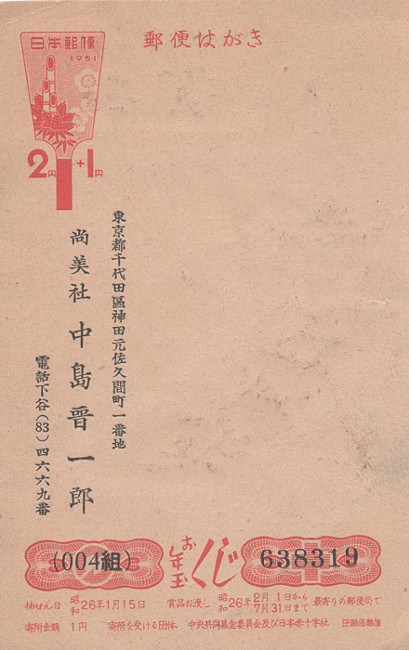 
|
|
unechan
Member 
Posts: 157
What I collect: pre WW2 Japan (mostly Meiji era classics and semi-classics); Japan revenue and cinderella; Germany infla
|
Post by unechan on Dec 25, 2018 14:32:09 GMT
Smauggie, As you have mentioned, the printing in black is indeed added to show the sender's address, Mr. Shin-ichiro Nakajima of Sho-Bi-Sha company, Tokyo. The printing on the reverse shows a rabbit writing the company's name, "Sho-Bi-Sha" 尚美社 at the Kakizome (link to Wikipedia) , which is a Japanese term (literally meaning "first writing") for the first calligraphy written at the beginning of the year. 1951 (Showa 26) was a year of "rabbit" in the japanese ganzhi (or sexagenary cycle), 干支, thus the picture of rabbit. Nice and cute one, I really like it  - Hironobu
|
|
unechan
Member 
Posts: 157
What I collect: pre WW2 Japan (mostly Meiji era classics and semi-classics); Japan revenue and cinderella; Germany infla
|
Post by unechan on Dec 25, 2018 14:47:17 GMT
|
|
|
|
Post by smauggie on Dec 25, 2018 15:17:11 GMT
Thank you for that information Hironobu. I was going to say that the rabbit design looked like a woodcut. It was the reverse side of the card that attracted me to it. If it had been blank I wouldn't have given it a second thought. |
|
unechan
Member 
Posts: 157
What I collect: pre WW2 Japan (mostly Meiji era classics and semi-classics); Japan revenue and cinderella; Germany infla
|
Post by unechan on Dec 28, 2018 11:39:37 GMT
Japan postal cards - with paper tags. Postal cards (stationeries) from Meiji era often bear paper tags, sometimes in massive numbers. Most of the reason for such tagging is to trace the recipient who cannot be found at the original address on the postcard. The tags tells the whole story by the postal clerk, postman and post offices on the delivery route, notifying the absence of the recipient, forwarding and returning and other commands/orders. Investigating the delivery route, often going back and forth between the post offices is like solving a puzzle, and it is so so impressive to see how the postal system in these days took care of delivering the post cards and letters to the addressee; something we cannot find today. (I personally do not know whether such paper-tagging system has been adopted in other countries or not, and would appreciate any information on this) Here is an example from my collection; 1 Sen blue Koban postcard (JSCA PC14) used in Meiji 26 (1893), fully covered with a bunch of paper tags.  The postcard is addressed to Kameoka, Tamba province from Kyoto.  - Hironobu |
|
unechan
Member 
Posts: 157
What I collect: pre WW2 Japan (mostly Meiji era classics and semi-classics); Japan revenue and cinderella; Germany infla
|
Post by unechan on Dec 28, 2018 12:03:18 GMT
Japan postal cards - with paper tags. The 1 Sen Koban blue postcard has 8 (!) paper tags attached, telling us the journey of the post card; - Posted at Kyoto on Jan 22, Meiji 26 and arrived Kameoka PO on Jan 23 (two date stamps on the front). Addressed to Mr. Tomita (?), working at a junior school in Kameoka, - Kameoka PO couldn't find the recipient at the original address (Tag 1), thus returned the post card to Kyoto PO (Tag 2), - Kyoto PO mentioned that the recipient shall be there (Tag 3) , so the post card resent to Kameoka PO and was asked for further investigation on Jan 23 (Tag 4), received by Kameoka PO on Jan 24 (Tag 5), - Kameoka PO tried again but without success (Tag 6), so returned the post card to Kyoto PO on Jan 24 (Tag 7), - Kyoto PO has admitted the absence of recipient, so the post card returned to the sender on Jan 24 (Tag 8). 
- Hironobu |
|
Deleted
Deleted Member
Posts: 0
|
Post by Deleted on Mar 29, 2019 13:32:44 GMT
1879-1898
1885 paid reply postcard = thank you unechan for notation- I have others and meant to include all the dates
Click on image for full view [imaged deleted by former member]
Sakura FC 4 |
|
salentin
Member  collecting Germany,where I live and about 20 more countries,half of them in Asia east of the Indus
collecting Germany,where I live and about 20 more countries,half of them in Asia east of the Indus
Posts: 6,506 
|
Post by salentin on Mar 29, 2019 17:36:40 GMT
Is it really a reply postcard ? According to Sakura there is no such card from 1879. |
|